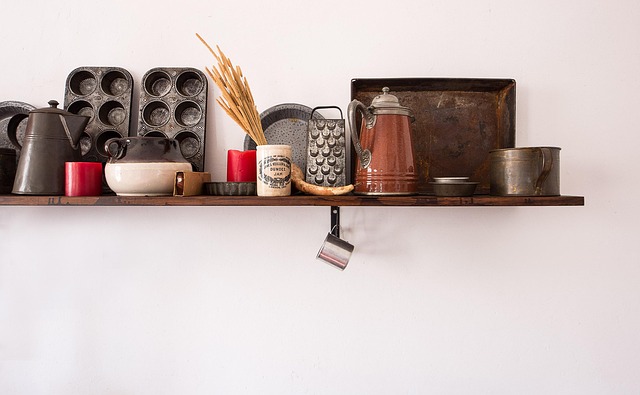Before selecting laminate kitchen flooring, measure your space, consider traffic patterns and light levels, and choose durable shades or patterns that complement your décor. Prepare by clearing the area, installing a protective underlayment, and securing boards from corners or longest walls using a rubber mallet. Cut and fit pieces around obstacles for a seamless, functional finish.
Looking to transform your kitchen with a fresh, modern look? Unique flooring materials like laminate kitchen flooring offer an array of benefits and endless design possibilities. This comprehensive guide explores everything you need to know about laminate flooring, from understanding your space and measuring for the perfect fit, to choosing stunning colors, patterns, and textures. We’ll also walk you through a step-by-step installation process, ensuring your dream laminate kitchen floor becomes a reality.
- Understanding Your Space: Measuring and Designing for Laminate Kitchen Flooring
- Benefits of Laminate Flooring: Durability, Ease, and Low Maintenance
- Choosing the Right Laminate Style: Colors, Patterns, and Textures for Every Taste
- Installation Tips: A Step-by-Step Guide to Fitting Your Dream Laminate Kitchen Floor
Understanding Your Space: Measuring and Designing for Laminate Kitchen Flooring
Before selecting laminate kitchen flooring, it’s essential to understand your space’s unique dimensions and layout. Measuring your kitchen accurately ensures that you buy enough material for a seamless installation without excess waste. Start by clearing the floor area of any furniture or obstructions and use measuring tape to determine the length and width of the space. Also, take note of any doors, windows, or other features that might affect flooring placement.
Once measured, consider your kitchen’s design and traffic patterns. High-traffic areas require more durable laminates capable of withstanding wear and tear. Kitchens with a lot of natural light may benefit from lighter laminate shades to reflect illumination, while darker tones can add warmth to spaces with less sunlight. Understanding these factors will help guide your choice in selecting the perfect laminate kitchen flooring for your space.
Benefits of Laminate Flooring: Durability, Ease, and Low Maintenance
Laminate flooring has gained immense popularity, especially for kitchens and other high-traffic areas, due to its remarkable benefits. One of the key advantages is durability; it can withstand heavy footfall, scuffs, and even accidental drops without showing signs of wear and tear. This makes laminate a cost-effective choice, as it requires less frequent replacement than natural materials.
Moreover, laminate flooring is incredibly easy to maintain and install. It’s scratch-resistant, which means it keeps its sleek appearance over time. Regular cleaning with mild detergent and water is all it needs to stay in top condition. This low-maintenance characteristic makes it a practical option for busy households, providing a clean and tidy space without the hassle of complex care routines.
Choosing the Right Laminate Style: Colors, Patterns, and Textures for Every Taste
When it comes to choosing the right laminate style, the options are virtually endless to suit every taste and space. For those seeking a timeless and elegant look, neutral tones like grey, beige, and taupe offer a subtle yet sophisticated appeal, especially well-suited for laminate kitchen flooring. On the other hand, bolder shades of oak, maple, or walnut add warmth and character, perfect for creating a cozy dining area.
Patterns and textures further enhance the versatility of laminate flooring. From realistic wood grain imitations to abstract designs, there’s a pattern to complement any décor style. For instance, intricate patterns can transform a room into a focal point, while more subtle textures blend seamlessly with existing decor. Whether you’re after a classic, rustic, or modern aesthetic, the right laminate floor can perfectly mirror your space’s personality.
Installation Tips: A Step-by-Step Guide to Fitting Your Dream Laminate Kitchen Floor
Installation Tips: Fitting Your Dream Laminate Kitchen Floor
When installing laminate kitchen flooring, preparation is key. Begin by clearing the space, removing existing floor coverings and ensuring the subfloor is clean, dry, and level. Measure your kitchen area precisely to get the right amount of laminate boards, which can be cut to fit odd shapes and corners. A good fit ensures both aesthetic appeal and prevents any gaps that could trap dirt or moisture.
Follow these steps for a seamless installation:
1. Layout Design: Plan your layout, considering traffic flow and desired design patterns. Use tape or markers to outline the floor’s shape and identify door swings.
2. Lay Underlayment: Place a suitable underlayment over the subfloor to provide cushioning, noise reduction, and extra protection against moisture. This is especially important in kitchens where water splashes are common.
3. Start Installation: Begin installing laminate from the longest wall or corner with a locking system. Use a rubber mallet to tap boards into place, ensuring each row locks securely into the previous one. Keep a consistent gap (usually 1/4 inch) between boards for expansion space.
4. Cut and Fit: For corners and edges, carefully cut laminate pieces using a utility knife or specialized tools. Fit them tightly around obstacles like cabinets and pipes to maintain a seamless finish.
When it comes to transforming your kitchen with laminate kitchen flooring, the options are endless. From measuring and designing to choosing the perfect style and installation, you now have the tools to create a space that’s both functional and beautiful. Remember, laminate flooring offers durability, ease of maintenance, and versatility—all at an affordable price point. With this comprehensive guide, you’re ready to take the next step in your home renovation journey.
